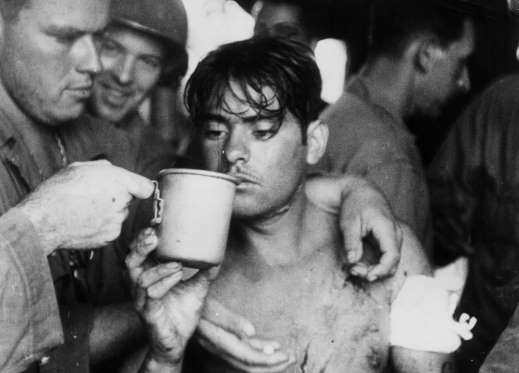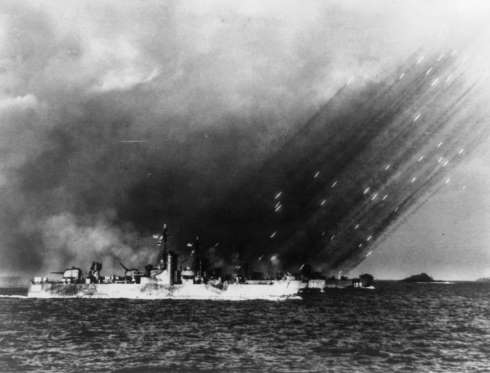 |
| American and Filipino soldiers hide in a fox-hole during the Battle of Bataan on April 7, 1942. |
 |
| Japanese troops capture an American gun during the Battle of Bataan, between January and April 1942. |
 |
| U.S. Marines come ashore from their landing craft during the early days of Battle of Guadalcanal in August 1942. |
 |
| American prisoners of war being marched by the Japanese troops during the Battle of Java (Feb. 28 – March 12, 1942). |
 |
| A captured Japanese 70-mm field gun is seen during the Battle of Guadalcanal on Oct. 23, 1942. |
 |
| American soldiers cross a makeshift bridge made from amphibious tractors as the base during the Guadalcanal Campaign, in November 1942. |
 |
| A human chain of soldiers remove supplies of oil from the flames after Japanese bombers attacked an U.S. Army Depot in New Guinea, circa 1943. |
 |
| U.S. Marines make their way through muddy terrain in Bougainville Island in Papua New Guinea, on Nov. 4, 1943. |
 |
| An injured Filipino soldier is treated by U.S. troops following a skirmish in Leyte, Philippines, circa 1943. |
 |
| Sandbags form a protective barrier around the entrance of a dugout surgery room in the Solomon Islands in 1943. |
 |
| American volunteer group aircraft, known as the "Flying Tigers," aid the Chinese Army against Japanese forces, circa 1943. |
 |
| A U.S. Marine holds a carbine rifle and ammo as his fellow soldier rears back to lob a grenade, during the Battle of Tarawa, in Kiribati in 1943. |
 |
| U.S. Marines examine a wrecked Japanese bomber on Munda Airfield in Solomon Islands on Aug. 20, 1943. |
 |
| A wave of charging Fourth Division U.S. Marines begin an attack from the beach at Iwo Jima, Japan on June 6, 1944. |
 |
| U.S. Air Force personnel fight fires caused by Japanese air raids on their base at Saipan Island in 1944. |
 |
| Shells from an American destroyer take out a Japanese fuel dump in Northern New Guinea, circa 1944. |
 |
| U.S. Marines form a line as they pass down munitions from landing craft carriers in the Solomon Islands, in the mid-1940s. |
 |
| American airmen, who found their way safely into China after their bombing run on Tokyo, Japan, pose with Chinese soldiers, circa 1944. |
 |
| The American forces deploy their 58th Amphibious Tanks and Tractor |
 |
| An American soldier pushes a baby carriage as he escorts a family to an internment camp during the Battle of Saipan in June 1944. |
 |
| An American landing craft brings in troops and supplies to the Filipino island of Leyte, while soldiers build a makeshift pier with sandbags in 1944. |
 |
| A landing vehicle carries U.S. artillery and personnel off New Guinea in 1944. |
 |
| American troops hold up a bullet-torn Japanese flag after capturing the Enewetak Atoll in the Marshall Islands, in 1944. |
 |
| An armada of American landing craft seen near an airstrip on Leyte Island on Nov. 21, 1944. |
 |
| U.S. Coast Guardsmen pose with a captured Japanese flag shortly after landing on Leyte island on Oct. 20, 1944. |
 |
| U.S. infantrymen photographed while taking a break on Bougainville Island in Papua New Guinea, in 1944. |
 |
| U.S. supply jeeps cross a makeshift bridge made from a base of pontoon boats, in New Guinea, circa 1944. |
 |
| A signpost at a military base in Tacloban, Philippines, points to the different hometowns of American soldiers, photographed in 1944. |
 |
| American servicemen on board a landing craft during the Battle of Guam, in 1944. |
 |
| Two soldiers plant an American flag on a beach in Guam on July 20, 1944. |
 |
| U.S. Marines take cover behind a Sherman tank nicknamed "King Kong" during the Battle of Saipan in 1944. |
 |
| Soldiers look on as a U.S. B-29 bomber takes off from Saipan on Nov. 23, 1944. |
 |
| Soldiers of the U.S. 29th infantry moves under cover of smoke during a field exercise in Okinawa, Japan, circa 1940s. |
 |
| The American flag is raised in the Solomon Islands to mark a victory over the Japanese forces in 1944. |
 |
| A crowd of soldiers listen to comedian Bob Hope as he entertains the troops in New Caledonia on Oct. 17, 1944. |
 |
| Trails of Japanese phosphorus bombs are seen over American planes as they fly back home after a raid in the Pacific on Oct. 15, 1944. |
 |
| Filipino civilians carry cases of field rations for the American troops through a jungle trail, on Leyte Island in October 1944. |
 |
| American forces bomb Hansa Bay in New Guinea, circa 1945. |
 |
| American paratroopers land in New Guinea, circa 1945. |
 |
| Misslies fly off an American vessel, aimed at Okinawa, Japan on March 31, 1945. |
 |
| American paratroopers land in New Guinea, circa 1945. |
 |
| U.S. personnel operate an M7 Priest carriage, overlooking the mountains of Luzon, Philippines in 1945. |
 |
A U.S. ship launches rockets at the shores of
|
 |
| A violent explosion staggers a Japanese ship during a bombing run by American B-25 Air Apache planes, off the coast of China on April 6, 1945. |
 |
| A Marine signals his companion to hold fire as a Japanese soldier emerges from a cave in Okinawa, persuaded by a smoke grenade, in 1945. |
 |
| U.S. soldiers of the XI Corps fire a howitzer gun at Japanese forces near Ipo Dam in the Philippines, in 1945. |
 |
| An aerial shot reveals a destroyed refinery in Tokyo, Japan – a result of aerial raids by American Boeing B-29 Superfortress planes, circa 1945. |
 |
| Widespread destruction is seen due to American bombings in Hiroshima, Japan, circa 1945. |
 |
Advancing American forces use explosive charges to attack the Japanese forces entrenched on the crest of a hill, circa 1945.
|
 |
| Marines wait at a cave entrance to ambush hiding Japanese soldiers, circa 1945. |
 |
| Smoke rises from the bomb-ridden city of Manila, Philippines in February 1945. |
 |
| American tanks are seen leaving a landing ship at the Lingayen Gulf in Philippines on Feb. 16, 1945. |
 |
| Soldiers raise the American flag on the island of Iwo Jima on Feb. 23, 1945. |
 |
| A U.S. Marine aims his flamethrower on an enemy cave in Okinawa in 1945. |
 |
| An American amphibious battalion forms a line as they dash for the shores of Okinawa in April 1945. |
 |
| U.S. Marines pose on top of Mount Suribachi on the island of Iwo Jima in 1945. |
 |
| A U.S. Marine braves machine gun fire as he rushes to his goal on the "Death Valley" in Okinawa, Japan in 1945. |
 |
| A U.S. Marine cemetery photographed at the foot of Mount Suribachi on the island of Iwo Jima, circa 1945. |















